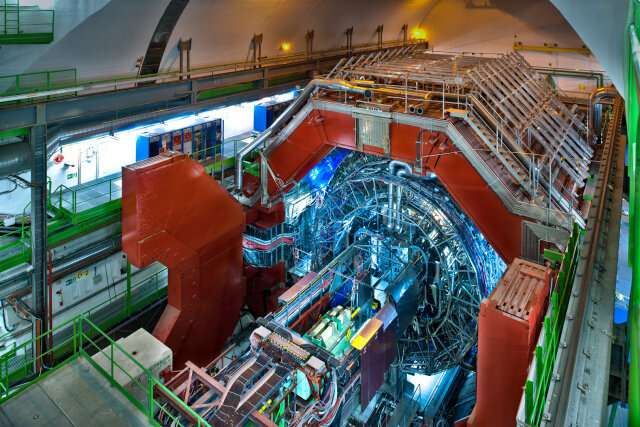Bottomonium particles don't go with the flow

A few millionths of a second after the Big Bang, the universe was so dense and hot that the quarks and gluons that make up protons, neutrons and other hadrons existed freely in what is known as the quark–gluon plasma. The ALICE experiment at the Large Hadron Collider (LHC) can recreate this plasma in high-energy collisions of beams of heavy ions of lead. However, ALICE, as well as any other collision experiments that can recreate the plasma, cannot observe this state of matter directly. The presence and properties of the plasma can only be deduced from the signatures it leaves on the particles that are produced in the collisions.
In a new article, presented at the ongoing European Physical Society conference on High-Energy Physics, the ALICE collaboration reports the first measurement of one such signature—the elliptic flow—for upsilon particles produced in lead–lead LHC collisions.
The upsilon is a bottomonium particle, consisting of a bottom (often also called beauty) quark and its antiquark. Bottomonia and their charm-quark counterparts, charmonium particles, are excellent probes of the quark–gluon plasma. They are created in the initial stages of a heavy-ion collision and therefore experience the entire evolution of the plasma, from the moment it is produced to the moment it cools down and gives way to a state in which hadrons can form.
One indication that the quark–gluon plasma forms is the collective motion, or flow, of the produced particles. This flow is generated by the expansion of the hot plasma after the collision, and its magnitude depends on several factors, including: the particle type and mass; how central, or "head on," the collision is; and the momenta of the particles at right angles to the collision line. One type of flow, called elliptic flow, results from the initial elliptic shape of non-central collisions.
In their new study, the ALICE team determined the elliptic flow of the upsilons by observing the pairs of muons (heavier cousins of the electron) into which they transform, or "decay." They found that the magnitude of the upsilon elliptic flow for a range of momenta and collision centralities is small, making the upsilons the first hadrons that don't seem to exhibit a significant elliptic flow.
The results are consistent with the prediction that the upsilons are largely split up into their constituent quarks in the early stages of their interaction with the plasma, and they pave the way to higher-precision measurements using data from ALICE's upgraded detector, which will be able to record ten times more upsilons. Such data should also cast light on the curious case of the J/psi flow. This lighter charmonium particle has a larger flow and is believed to re-form after being split up by the plasma.
More information: Measurement of Υ(1S) elliptic flow at forward rapidity in Pb-Pb collisions at √sNN=5.02 TeV. arxiv.org/abs/1907.03169
Provided by CERN




















